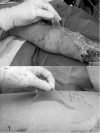Toxic epidermal necrolysis after acute burn injury
- PMID: 30983926
- PMCID: PMC6441584
Toxic epidermal necrolysis after acute burn injury
Abstract
Toxic epidermal necrolysis is a rare, potentially fatal disorder that involves large areas of skin desquamation. Patients with toxic epidermal necrolysis are frequently referred to burn centres for expert wound management and early comprehensive critical care as this has been shown to improve patient outcome and mortality. The authors describe the first report of medication-induced toxic epidermal necrolysis occurring in a patient during acute burn management in a tertiary burn care facility. The patient sustained a 17% total body surface area flame burn to her face, chest, bilateral upper limbs and bilateral lower limbs while escaping from a wildfire. She required extensive debridement and allografting to manage burn injured areas and additional areas of epidermal loss from subsequent toxic epidermal necrolysis, amounting to a total body surface area of 90%. Definitive burn wound closure was achieved using autologous split-thickness skin grafting once donor sites healed and became suitable for harvest 3 weeks after the onset of toxic epidermal necrolysis. Grafts achieved complete take and the patient was discharged home following rehabilitation..
La nécrolyse épidermique toxique est une pathologie rare potentiellement mortelle entraînant des desquamations cutanées étendues. Ces patients sont fréquemment hospitalisés dans un CTB, en raison de leur expertise des soins locaux et de la réanimation, ce qui contribue à l’amélioration du pronostic et à la baisse de la mortalité. Nous rapportons le premier cas de nécrolyse épidermique toxique liée à un médicament survenu au cours du traitement en CTB d’une patiente brûlée. Elle souffrait d’une brûlure sur 17% SCT intéressant le visage, le thorax et les 4 membres, ayant nécessité excision et greffes. Celles –ci n’ont pu être réalisées que tardivement, en raison d’un défaut de site donneurs car la patient a développé une nécrolyse épidermique toxique sur 90% SCT ne les ayant laissé utilisables que 3 semaines plus tard. Les greffes se sont bien intégrées et la patiente a pu retourner à domicile après rééducation..
Keywords: Lyell’s syndrome; Stevens-Johnson syndrome; allograft; burn; toxic epidermal necrolysis.
Figures



References
-
- Roujeau JC. The spectrum of Stevens-Johnson syndrome and toxic epidermal necrolysis: a clinical classification. J Invest Dermatol. 1994;102(6):28S–30S. - PubMed
-
- Creamer D, Walsh SA, Dziewulski P. UK guidelines for the management of Stevens-Johnson syndrome/toxic epidermal necrolysis in adults 2016. J Plast Reconstr Aesthet Surg. 2016;69(6):e119–e153. - PubMed
-
- Garcia-Doval I, LeCleach L, Bocquet H, Otero XL, Roujeau JC. Toxic epidermal necrolysis and Stevens-Johnson syndrome: does early withdrawal of causative drugs decrease the risk of death? Arch Dermatol. 2000;136(3):323–327. - PubMed
-
- Spies M, Sanford AP, Aili Low JF, Wolf SE, Herndon DN. Treatment of extensive toxic epidermal necrolysis in children. Pediatrics. 2001;108(5):1162–1168. - PubMed
-
- Paggiaro AO, E Silva Filho ML, de Carvalho VF, Isaac C, Gemperli R. The role of biological skin substitutes in Stevens-Johnson syndrome: systematic review. Plast Surg Nurs. 2018;38(3):121–127. - PubMed
LinkOut - more resources
Full Text Sources
